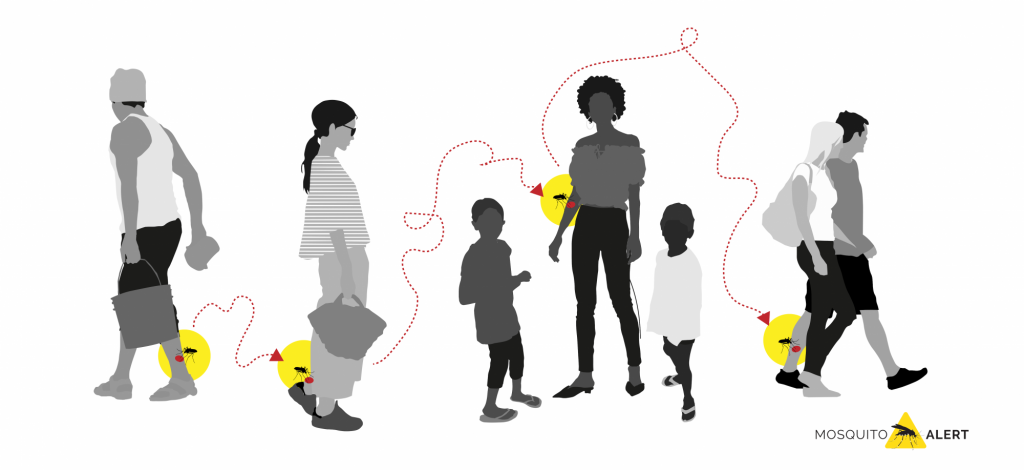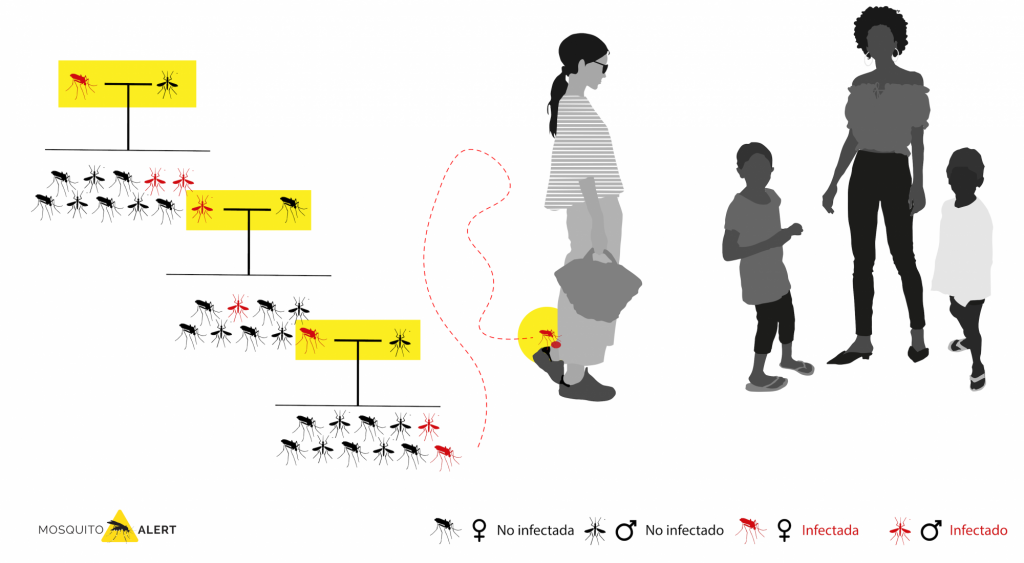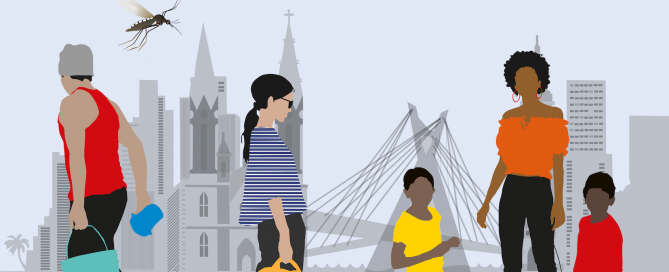In 2019, the World Health Organization (WHO) included dengue among the 10 priorities of its strategic plan. For decades the threat of the disease has been growing, with more and more cases in the regions where it is endemic, and expanding to neighboring areas that were not affected. WHO estimates that 40% of the world’s population is at risk of contracting the disease, calculating that there are 390 million cases per year.
Throughout 2019, Latin America has experienced the worst dengue epidemic in its history, according to the Pan American Health Organization (PAHO). This organization has accounted for more than 3 million dengue infections and 1,583 deaths in Latin America and the Caribbean.
In America, the dengue cycle is basically urban, being the yellow fever mosquito, Aedes aegypti, the main transmitting agent. The tiger mosquito, Aedes albopictus, is also capable of transmitting the disease, but it does not appear to be as effective as Aedes aegypti. The way to be infected by dengue virus (DENV) is through the bite of a female mosquito, which in turn has been previously infected by biting a person infected with the virus (fig. 1).

Fig. 1. Horizontal transmission of dengue, in which a mosquito transmits the virus from one person to another. First it is spread by biting a person with the virus and then is able to transmit it to a person. The virus chain is: person –> mosquito –> person. Source: Mosquito Alert ((CC-BY-NC-2.0)
The most normal thing is that a mosquito becomes infected by biting an affected person, it is what in epidemiology is known as horizontal transmission (fig. 1). The virus passes from a human to a mosquito, and from the mosquito passes to another human. However, there is another possible route of infection to keep the virus circulating in one place: vertical transmission (fig. 2). This occurs when a mosquito transmits the virus to its offspring, so that the virus passes from an infected female to the eggs, staying in the larvae until reaching the adult stage. In this way, new mosquitoes infected with the virus appear, and therefore, capable of transmitting it, without first biting any infected person.
Vertical transmission could help keep the virus in an area between epidemics
It is suspected that in areas where the disease is endemic, the virus may persist thanks to vertical transmission during low-mosquito seasons, since there are few mosquitoes, horizontal transmission is more difficult to occur. Some laboratory studies with Aedes aegypti and Aedes albopictus have shown that the virus can be passed from one generation to another for three or seven generations. A recent review study has confirmed how important this phenomenon can be in keeping the virus in circulation.
Vertical transmission in natural conditions has been described in both Asia and America. In Asia, this type of transmission has been confirmed in Thailand, India, Malaysia, Singapore, Indonesia and the Philippines. In America it has been detected in Trinidad and Tobago, Bolivia, Argentina, Peru, Mexico, Costa Rica and Brazil. A new work carried out in São Paulo confirms the persistence of the virus in the city through vertical transmission in a tiger mosquito.

Fig. 2. Vertical transmission of dengue, the virus is transmitted from an infected female (red) to the next generation. The virus can be transmitted over several generations of mosquitoes, until the vertical transmission can become horizontal by biting an infected mosquito to a person, thus being able to initiate a new outbreak of dengue. Source: Mosquito Alert ((CC-BY-NC-2.0)
For this, they collected eggs of Aedes aegypti and Aedes albopictus in one of their urban parks throughout 2014, 2015 and 2016. Once in the laboratory they allowed the eggs to develop to later analyze the adults in search of dengue virus. In total, 5,730 mosquitoes were analyzed, of which 3,270 were Aedes albopictus (1,480 females and 1,790 males) and 2,460 Aedes aegypti (1,520 females and 940 males). Among them they found a few male tiger mosquitoes infected with dengue virus.
Environmental conditions may condition vertical transmission
The study confirms the ability of the tiger mosquito to transmit the virus vertically. Other research has also demonstrated the ability of Aedes aegypti, but with a lower ratio. The data suggests that although Aedes aegypti is the first horizontal transmission agent, its role would be less important in maintaining the virus during periods when there are few mosquitoes. During these periods, the vertical transmission of Aedes albopictus could be more important to keep the virus circulating.
Previously it had been proven that mosquitoes that resulted from eggs that had long been without hatching, were more infected by such vertical transmission, than those eggs that hatched quickly because environmental conditions were favorable to the development of larvae. It is believed that in eggs that take longer to hatch, the virus can be copied more times and be more abundant until it infects the embryo. So in the less favorable periods for mosquito breeding, vertical transmission could be especially relevant. In periods of drought, in which the eggs are forced to remain in this stage for a longer time waiting for the rains that allow the development of aquatic larvae, it would be expected that a greater number of mosquitoes infected by the mother would appear.
During droughts mosquitoes can become more aggressive, bite more and increase the risk of disease transmission
The surprising thing about the study carried out in São Paulo is that no cases of dengue have been detected in humans since 2010, but the virus seems to have been circulating vertically all this time. It reinforces the hypothesis that vertical transmission between generations of mosquitoes can keep the virus between one epidemic and another. A silent circulation of the virus maintained by the tiger mosquito that at any given time can become horizontal transmission. These studies show how much remains to be known about a disease that affects so many people, and what implies that in one region the two species of mosquito, Aedes aegypti and Aedes albopictus coexist, from an epidemiological point of view, as reservoirs of the virus and as the origin of an epidemiological outbreak.
Vertical transmission can make dengue control difficult
An epidemiological model suggests that vertical transmission may contribute to the difficulty of controlling dengue. According to their model, based on data from the dengue epidemic that Peru suffered in 2000-2001, epidemiological outbreaks become more difficult to control when there is vertical transmission. When an epidemic is caused by a virus strain unable to be transmitted vertically, it is easier to control, but it becomes more complicated when there is vertical transmission. The ability of the virus to be transmitted vertically has a high genetic component, depending on the virus strain and mosquito populations.
References
Adams B, Boots M. 2010. How important is vertical transmission in mosquitoes for the persistence of dengue? Insights from a mathematical model. Epidemics 2: 1-10
Danis-Lozano R, Díaz-González EE, Malo-García IR, Rodríguez MH, Ramos-Castañeda J, Juárez-Palma L, Ramos C, López-Ordóñez T, Mosso-González C, Fernández-Salas I. 2019. Vertical transmission of dengue virus in Aedes aegypti and its role in the epidemiological persistence of dengue in Central and Southern Mexico. Tropical Medicine & International Health 24: 1311-1319
Espinosa M, Giamperetti S, Abril M, Saijo A. 2014. Vertical transmission of dengue virus in Aedes aegypti collected in Puerto Iguazú, Misiones, Argentina. Revista del Instituto de Medicina Tropical de Sao Paulo 56: 165-167
Ferreira-de-Lima VH, Lima-Camara TN. 2018. Natural vertical transmission of dengue virus in Aedes aegypti and Aedes albopictus: a systematic review. Parasites & Vectors 11: 77
Ferreira-de-Lima VH, Andrade PS, Thomazelli LM, Marrelli MT, Urbinatti PR, Sá Almeida RM, Lima-Camara TN. 2020. Silent circulation of dengue virus in Aedes albopictus (Diptera: Culicidae) resulting from natural vertical transmission. Scientific Reports 10: 3855
Joshi V, Mourya DT, Sharma RC. 2002. Persistence of dengue-3 virus through transsovarial transmission passage in successive generations of Aedes aegypti mosquitoes. American Journal of Tropical Medicine and Hygiene 67: 158-161
Mourya DT, Gokhale, Basu A, Barde PV, Sapkal GN, Pabdidri VS, Gore MM. 2001. Horizontal and vertical transmission of dengue virus type 2 in highly and lowly susceptible strains of Aedes aegypti mosquitoes. Acta Virologica 45: 67-71
Murillo D, Murillo A, Lee S. 2019. The role of vertical transmission in the control of dengue fever. International Journal of Environmental Research and Public Health 16: 803
Organización Panamericana de la Salud. 2020. El dengue en las Américas alcanza el mayor número de casos registrados en la historia
Shroyer DA. 1990. Vertical maintenance of dengue-1 virus in sequential generations of Aedes albopictus. Journal of Mosquito Control Association 6: 312-314




